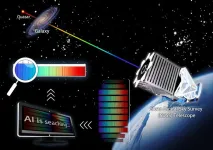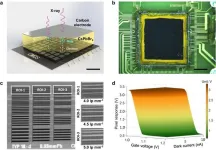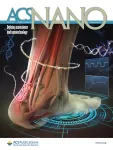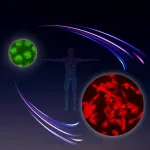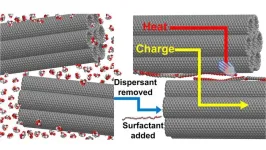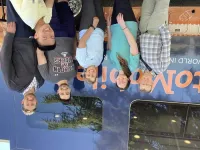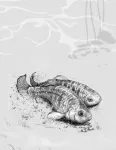(Press-News.org) Recently, an international team led by Prof. GE Jian from the Shanghai Astronomical Observatory of the Chinese Academy of Sciences conducted a search for rare weak signals in quasar spectral data released by the Sloan Digital Sky Survey III (SDSS-III) program using deep learning neural networks. By introducing a new method to explore galaxy formation and evolution, the team showcased the potential of artificial intelligence (AI) in identifying rare weak signals in astronomical big data. This study was published in Monthly Notices of the Royal Astronomical Society.
"Neutral carbon absorbers" from cold gas with dust in the universe serve as crucial probes for studying galaxy formation and evolution. However, the signals of neutral carbon absorption lines are weak and extremely rare. Astronomers have struggled to detect these absorbers in massive quasar spectral datasets using conventional correlation methods. "It's like looking for a needle in a haystack," said Prof. GE. In 2015, 66 neutral carbon absorbers were discovered in the spectra of tens of thousands of quasars released earlier by SDSS, which is the largest number of samples obtained.
In this study, Prof. GE's team designed and trained deep neural networks with a large number of simulated samples of neutral carbon absorption lines based on actual observations. By applying these well-trained neural networks to the SDSS-III data, the team discovered 107 extremely rare neutral carbon absorbers, doubling the number of the samples obtained in 2015, and detected more faint signals than before.
By stacking the spectra of numerous neutral carbon absorbers, the team significantly enhanced the ability to detect the abundance of various elements and directly measured metal loss in gas caused by dust. The results indicated that these early galaxies, containing neutral carbon absorber probes, have undergone rapid physical and chemical evolution when the universe was only about three billion years old (the current age of the universe is 13.8 billion). These galaxies were entering a state of evolution between the Large Magellanic Cloud (LMC) and the Milky Way (MW), producing a substantial amount of metals, some of which bonded to form dust particles, leading to the observed effect of dust reddening.
This discovery independently corroborates recent findings by the James Webb Space Telescope (JWST) which detected diamond-like carbon dust in the earliest stars in the universe, suggesting that some galaxies evolve much faster than previously expected, challenging existing models of galaxy formation and evolution.
Unlike the JWST, which conducts research through galaxy emission spectra, this study investigates early galaxies by observing the absorption spectra of quasars. Applying well-trained neural networks to find neutral carbon absorbers provides a new tool for future research on the early evolution of the universe and galaxies, complementing the JWST’s research methods.
"It is necessary to develop innovative AI algorithms that can quickly, accurately, and comprehensively explore rare and weak signals in massive astronomical data," said Prof. GE. The team aims to promote the method introduced in this study to image recognition by extracting multiple related structures to create artificial "multistructure" images for efficient training and detection of faint image signals.
END
'Hunting for treasures' with AI: Astronomers detect rare neutral atomic-carbon absorbers with deep neural network
2024-05-21
ELSE PRESS RELEASES FROM THIS DATE:
Researchers develop perovskite X-ray detector for medical imaging
2024-05-21
Technology (SIAT) of the Chinese Academy of Sciences, in collaboration with researchers at Central China Normal University, have developed a high-performance perovskite X-ray complementary metal-oxide-semiconductor (CMOS) detector for medical imaging.
The study was published in Nature Communications on Feb. 21.
X-ray imaging is vital for the diagnosis and treatment of cardiovascular and cancer diseases. Direct-conversion X-ray detectors made of semiconductor materials exhibit superior spatial and temporal resolution at lower radiation doses compared to indirect-conversion detectors made of scintillator materials. However, the currently available semiconductor ...
Rice chemist Gustavo Scuseria wins 2024 Schrödinger Medal
2024-05-21
By Jade Boyd
Special to Rice News
Pioneering Rice University chemist Gustavo Scuseria has won the 2024 Schrödinger Medal from the World Association of Theoretical and Computational Chemists.
Awarded annually to a single recipient, the medal recognizes an outstanding body of work in theoretical and computational chemistry. Scuseria has pioneered quantum computational methods that are widely used to study the complex quantum states and electronic properties of a wide range of molecules and materials. In awarding the medal, ...
Monitoring the recovery process accurately with a medical needle and thread!
2024-05-21
□ DGIST (President Kunwoo Lee) announced on the 16th (Tue) that a research team led by Professor Jaehong Lee of the Department of Robotics and Mechanical Electronics has developed a new human implantable, wireless, health monitoring electronic suture system through joint research with a team from Yonsei University and Korea University. The developed wireless electronic suture can be easily applied in the medical field and is expected to be used in various orthopedic fields, such as patient-customized rehabilitation.
□ ...
One essential step for a germ cell, one giant leap for the future of reproductive medicine
2024-05-21
KYOTO, Japan – May 20, 2024
Infertility affects approximately 1 in 6 people in their lifetime worldwide according to the World Health Organization (WHO). Infertility —as defined by the American Society for Reproductive Medicine (ASRM)— is a disease, condition, or status characterized by “the inability to achieve a successful pregnancy based on a patient’s medical, sexual, and reproductive history, age, physical findings, diagnostic testing, or any combination of those factors” or requiring medical intervention such as the use of mature donor gametes “to achieve a successful pregnancy ...
Powering wearable devices with high-performing carbon nanotube yarns
2024-05-21
Ikoma, Japan – With the growth of the Internet of Things, sustainable solution for powering wireless sensors and devices are considered important. Thermoelectric generators, for example, which have the ability to convert waste heat into electricity can offer a sustainable solution. Researchers around the world have been working on such solutions. A research team, led by Masakazu Nakamura from Nara Institute of Science and Technology (NAIST), Japan has also been working on flexible wearable thermoelectric generators that produce electricity from body heat by sewing nanomaterial called carbon nanotubes (CNTs) into fabric.
Effective ...
Genes provide hope for the survival of Arabia’s last big cat
2024-05-21
The authors of a major study on the Critically Endangered Arabian leopard say that the release of captive bred animals carefully selected for their genes can make a significant contribution to the successful recovery of the dwindling wild population and avert the prospect of extinction.
An international collaboration led by scientists from the Durrell Institute of Conservation and Ecology (DICE) at the University of Kent, University of East Anglia (UEA), University College London (UCL), Nottingham-Trent University (NTU) and the Diwan of Royal Court in Oman, surveyed the remote Dhofar mountain range of southern Oman to determine how many of Arabia’s last big cat survive.
By ...
Auburn biologists publish first work on avian migration conducted in the AU MitoMobile
2024-05-21
For Wendy Hood and Geoffrey Hill in Biological Sciences, Andreas Kavazis in Kinesiology, and their team, Emma Rhodes, Paulo Mesquita, and Jeff Yap, traveling the country to unlock the mystery of mitochondria in migrating aviary species has allowed them to make a significant contribution to research in an area that has not been investigated before. The first publication conducted in the AU MitoMobile van is featured in Scientific Reports, “Flexibility underlies differences in mitochondrial respiratory performance between ...
Second Phase 3 clinical trial again shows dupilumab lessens disease in COPD patients with type 2 inflammation
2024-05-20
BIRMINGHAM, Ala. – Chronic obstructive pulmonary disease patients with type 2 inflammation may soon gain access to a new drug — dupilumab — that showed rapid and sustained improvements in patients in a pivotal Phase 3 clinical trial, researchers report in the New England Journal of Medicine. This monoclonal antibody is the first biologic shown to improve clinical outcomes in COPD. The data supporting the use of dupilumab in COPD will be reviewed by the United States Food and Drug Administration in June.
The disease improvements — as measured by a significantly ...
Autoimmune disease not associated with monoclonal gammopathy
2024-05-20
Embargoed for release until 5:00 p.m. ET on Monday 20 May 2024
Annals of Internal Medicine Tip Sheet
@Annalsofim
Below please find summaries of new articles that will be published in the next issue of Annals of Internal Medicine. The summaries are not intended to substitute for the full articles as a source of information. This information is under strict embargo and by taking it into possession, media representatives are committing to the terms of the embargo not only on their own behalf, but also on behalf of the organization they represent.
----------------------------
1. ...
Purdue-led fishing expedition nets new pupfish family member in New Mexico
2024-05-20
Purdue-led fishing expedition nets new pupfish family member in New Mexico
Genetic drift, not natural selection, identified as main factor driving speciation
WEST LAFAYETTE, Ind. Scientists have identified a new member on the genetic family tree of an endangered pupfish native to south-central New Mexico.
“We went into this thinking that there was one species of conservation concern,” said J. Andrew DeWoody, professor of genetics in Purdue University’s Department of Forestry and Natural Resources. “The preponderance of evidence ...
